South Holston River Map: A Guide to Wade and Float Fishing the Tailwater
Nestled in the rolling landscapes of the Appalachian Mountains, the South Holston River emerges as a sanctuary for fly fishing aficionados. This river, with its crystal-clear waters and robust populations of brown and rainbow trout, has earned its reputation as a premier fly fishing destination in the Southeast. The South Holston River offers a diverse range of fishing experiences, from serene pools to vibrant, insect-laden hatches, drawing anglers from all corners seeking the thrill of the catch in its picturesque flows.
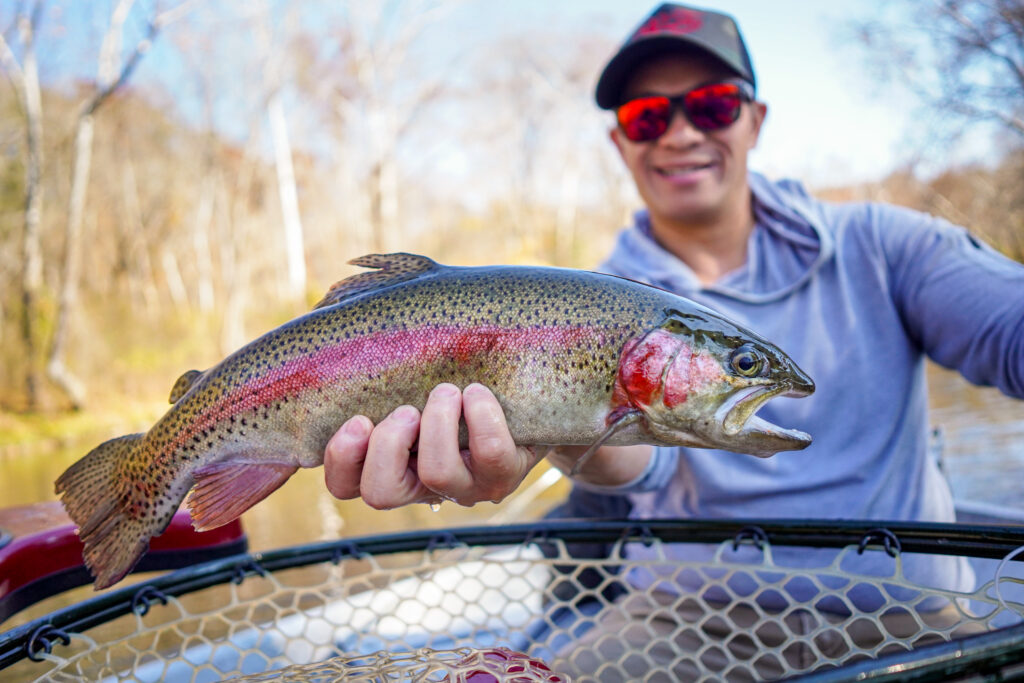
The importance of familiarizing oneself with the South Holston River map cannot be overstated for those looking to maximize their fishing endeavors. A detailed understanding of the river’s geography—knowing its twists and turns, the locations of its riffles, pools, and rapids—can significantly enhance an angler’s success. Identifying the prime spots for wade and float fishing, understanding the access points along the river, and recognizing the sections that hold the highest potential for trophy catches are all crucial pieces of knowledge. This intimate acquaintance with the river’s layout not only aids in strategic planning but also ensures a more fruitful and enjoyable fishing experience, allowing anglers to seamlessly merge with the river’s natural rhythm and beauty.
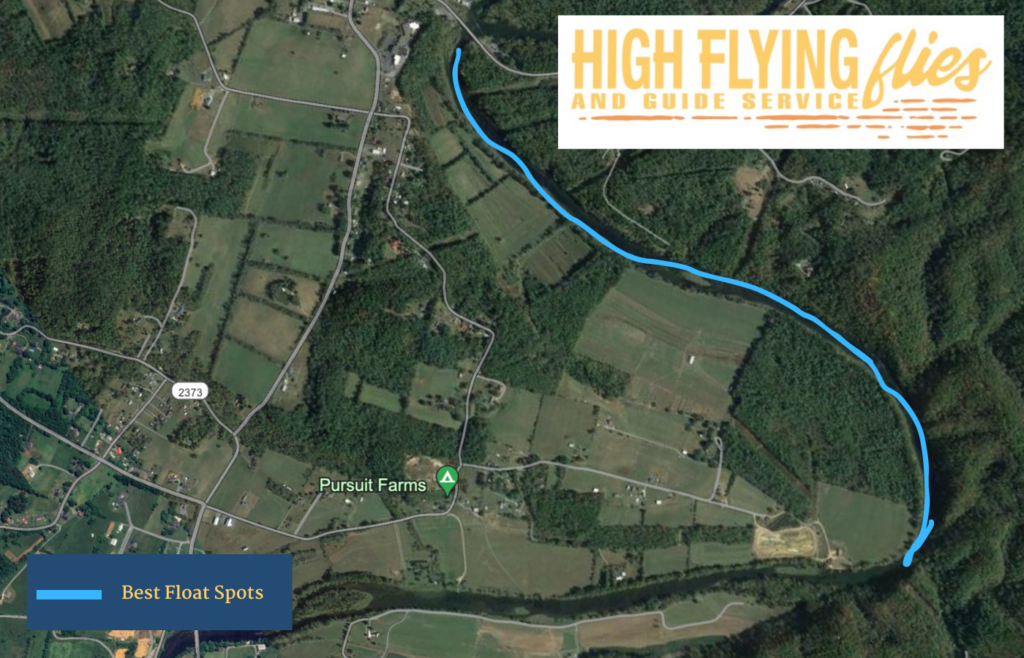
Float Fishing Sections
Emmett Bridge to Spawning Ground
The stretch from Emmett Bridge to the Spawning Ground represents one of the South Holston River’s most dynamic and fruitful float fishing sections. This portion of the river is characterized by its diverse water types, including steady flows, occasional rapids, and deep pools that challenge and reward the keen angler. The river’s topography here is a blend of natural and man-made features, offering a variety of habitats for trout.
Anglers floating this section can expect to encounter a healthy population of brown and rainbow trout, with the brown trout being particularly notable for their size and abundance. This area is also known for significant aquatic insect hatches, which can provide outstanding dry fly fishing opportunities during the right conditions
Navigating the waters from Emmett Bridge to the Spawning Ground requires attentiveness to water levels and flow rates, which can vary significantly. It’s important to be equipped with a versatile selection of flies to match the hatches you encounter, including nymphs for deeper waters and dry flies for surface feeding. Successful navigation and fishing in this section often depend on the ability to adapt to the river’s changing moods, making it a thrilling experience for those who take the time to understand its nuances.
***It’s important to note that the spawning section is off-limits for fishing from Nov. 1 to Feb. 1 each year. You can learn more about that by visiting TWRA’s website and reading about their management plan.
Hickory Tree Rapids
The Hickory Tree Rapids section of the South Holston River presents a unique set of water conditions and challenges that distinguish it from the quieter stretches of the river. Characterized by faster-moving waters and a series of rapids, this area demands skill and precision from the angler. The turbulence and oxygenation created by the rapids make it a prime habitat for trout, who are attracted to the abundant food sources churned up in the waters.
Fishing in Hickory Tree Rapids requires an adaptable approach. High-water conditions amplify the rapids, necessitating the use of heavier nymphs to reach the deeper pockets where trout hold. Streamers can also be effective in these conditions, mimicking the baitfish and larger insects disoriented by the swift currents. During lower flows, dry flies and smaller nymphs can be productive, especially when targeting areas where the water slows and fish gather to feed. Key fly patterns include beadhead nymphs, woolly buggers, and caddis imitations, chosen to match the prevalent hatches and appeal to the river’s discerning trout.
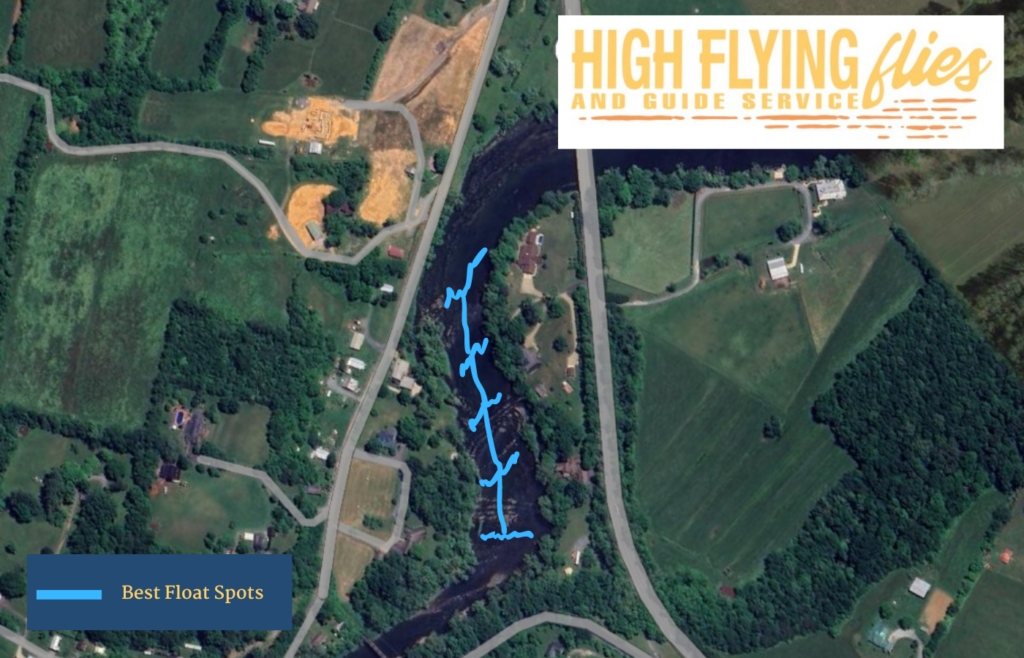
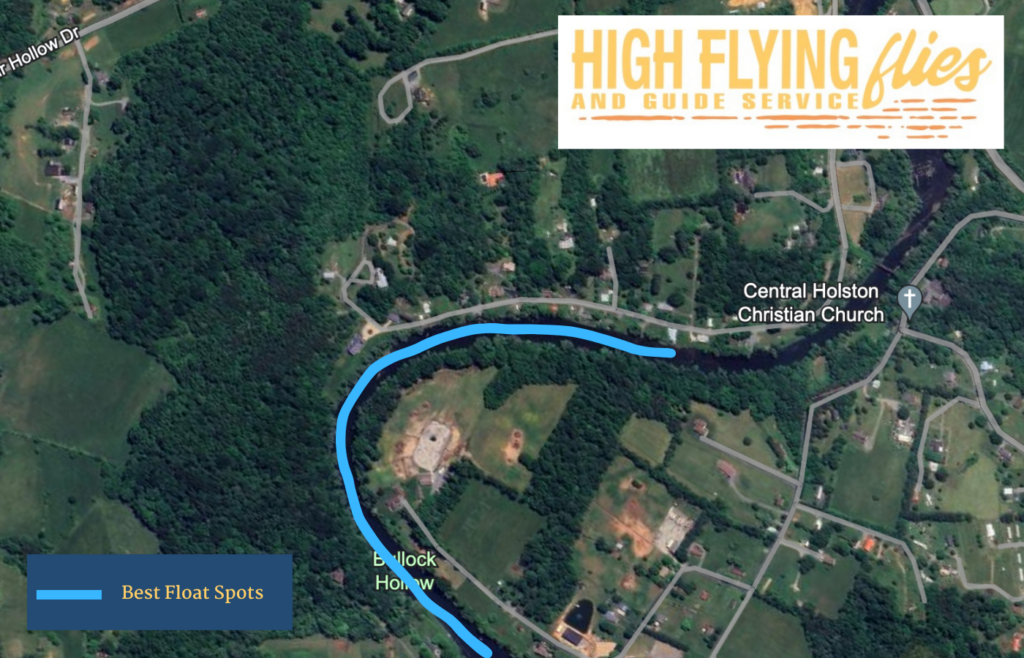
The Horse Farm
The Horse Farm stretch of the South Holston River is renowned for its serene beauty and excellent fishing conditions. This picturesque segment offers a tranquil backdrop of rolling hills and grazing lands, creating a peaceful ambiance for anglers. The river here flows gently, marked by a mix of shallow riffles and deeper holes, providing diverse habitats for a healthy population of brown and rainbow trout. The presence of aquatic vegetation and submerged structures contributes to the richness of the aquatic ecosystem, attracting significant insect hatches that sustain the river’s trout.
To maximize the fishing potential on a float trip through The Horse Farm, anglers should focus on versatility and observation. Starting with streamers in the early hours can yield rewarding catches as trout actively hunt for baitfish. As the day progresses and insect activity increases, switching to dry flies or nymphs in response to observed hatches can significantly improve catch rates. Key strategies include carefully drifting flies along seams and edges of deeper pools, and staying attentive to the trout’s feeding patterns. This approach, combined with the stunning surroundings, makes The Horse Farm a must-visit section for any angler seeking both the thrill of the catch and the beauty of the South Holston River.
Wade Fishing Sections
Wade fishing offers an intimate connection with the river, allowing anglers to immerse themselves in the rhythms of the water and the natural environment. The South Holston River, with its clear, cold waters and abundant trout, provides an exceptional setting for wade fishing enthusiasts. This guide highlights key sections along the river that are accessible for wading, each offering unique opportunities to engage with the aquatic life below the surface. From the oxygen-rich flows at the Weir Dam to the hidden gems along Big Springs Rd, these areas cater to a range of fishing styles and preferences. Whether you’re a seasoned angler seeking the solitude of the stream or a beginner looking to make your first cast, the wade fishing sections of the South Holston River promise a rewarding experience.
The Weir Dam
Fishing near the Weir Dam on the South Holston River offers a distinctive experience, thanks to the unique water features and ecological conditions created by the dam’s structure. This area is characterized by consistent water flows and temperatures, providing an ideal habitat for a diverse range of insect life and, consequently, a thriving trout population. The steady release of water ensures that the area remains a hotspot for fishing, even when other parts of the river might experience low water levels.
When fishing near the Weir Dam, the use of small nymphs and midge patterns can be particularly effective, as these imitate the natural diet of the trout in this section. Techniques such as sight fishing become invaluable here, where the clear waters allow anglers to spot trout and present flies with precision. Additionally, during hatch periods, switching to dry flies can offer exhilarating surface action. Successful fishing in this area often comes down to observation, patience, and a delicate presentation, making it a rewarding challenge for any fly fisherman.
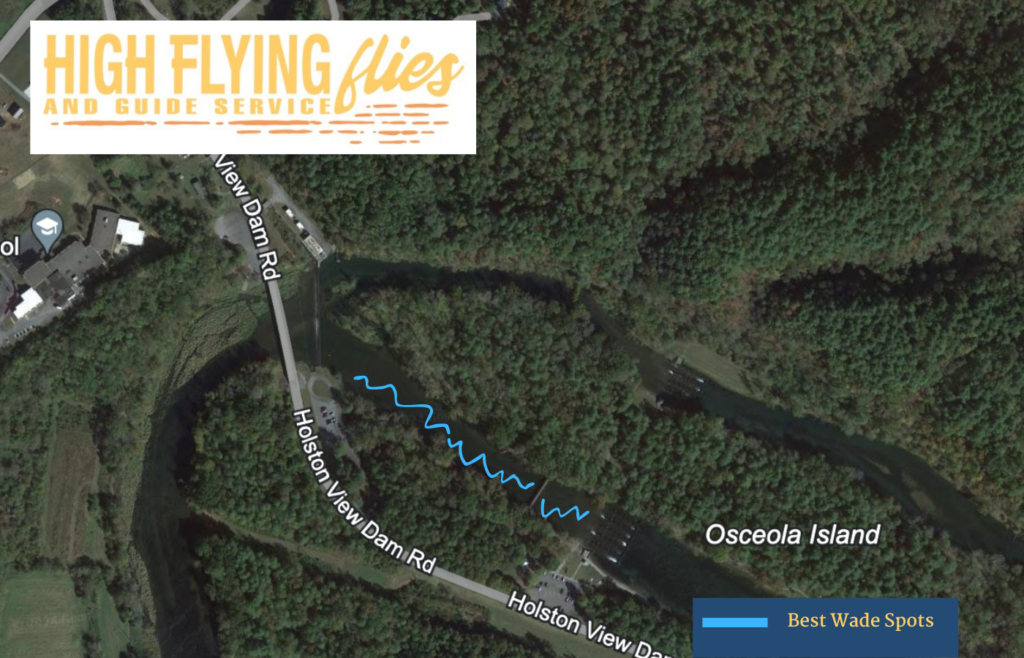
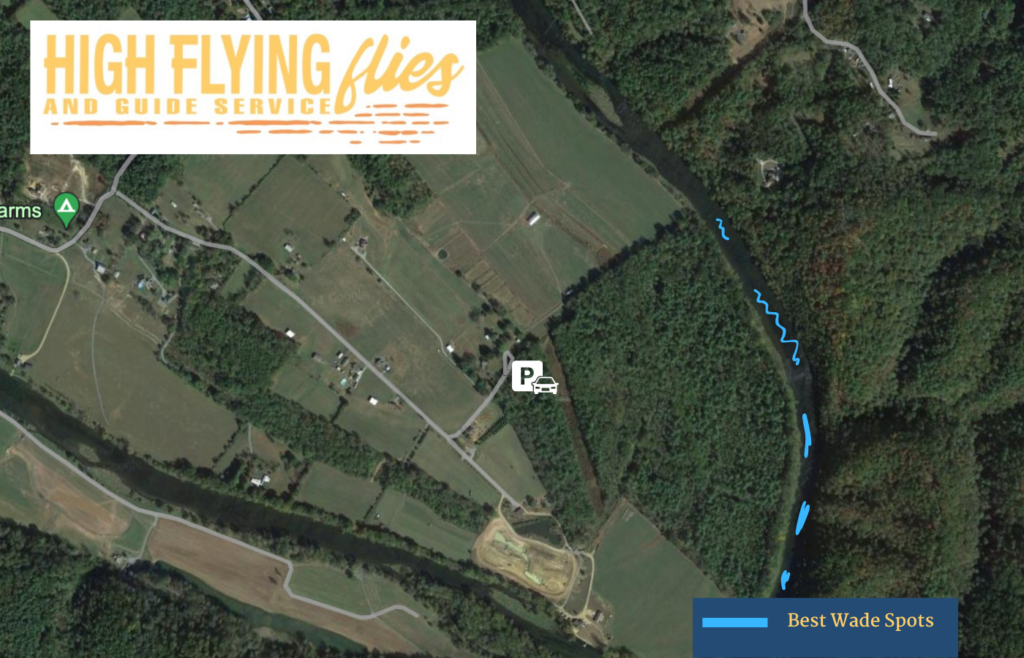
Bouton Trailhead Area (The Culdesac)
The Bouton Trailhead Area provides convenient access to one of the South Holston River’s most scenic and fruitful stretches for wade fishing. Nestled within a serene setting, this area offers anglers easy entry to a variety of water types, from gentle riffles to deeper runs, all teeming with trout. The diversity of the aquatic environment here supports a rich insect life, setting the stage for productive fishing sessions.
To make the most out of fishing near the Bouton Trailhead, anglers should adopt a stealthy approach, as the clear waters and wary trout demand a careful presentation. Dry fly fishing can be particularly rewarding in this section, especially during hatch periods when trout actively feed on the surface. Nymphing along the deeper runs and around submerged structures can also yield good results. Key tips include paying attention to water flows and insect activity, selecting flies that closely mimic the local hatch, and maintaining a low profile to avoid spooking the fish. With its accessible spots and abundant fish, the Bouton Trailhead Area is a haven for those seeking a peaceful yet productive day on the water.
The Old Railroad Bridge off of Sand Barr Rd
The area surrounding the Old Railroad Bridge off of Sand Barr Rd is steeped in history and natural beauty, offering a unique backdrop for wade fishing on the South Holston River. This section is characterized by its varied water types, with gentle riffles giving way to deeper pools that harbor sizeable trout. The mix of fast and slow waters, combined with the presence of underwater structures, creates ideal conditions for both feeding trout and the aquatic insects they prey upon.
For anglers wading near this historic landmark, a strategic approach is key. Focusing on seams and transitions between different water speeds can be particularly productive. Fly selection should include a mix of nymphs and streamers to target the deeper pools, while dry flies are effective during hatch periods for surface feeding. Stealth and patience are crucial in this area, as the clear waters and the wary nature of the trout require a subtle presentation. This spot, rich in both history and fish, provides a rewarding experience for those who approach it with respect and finesse.
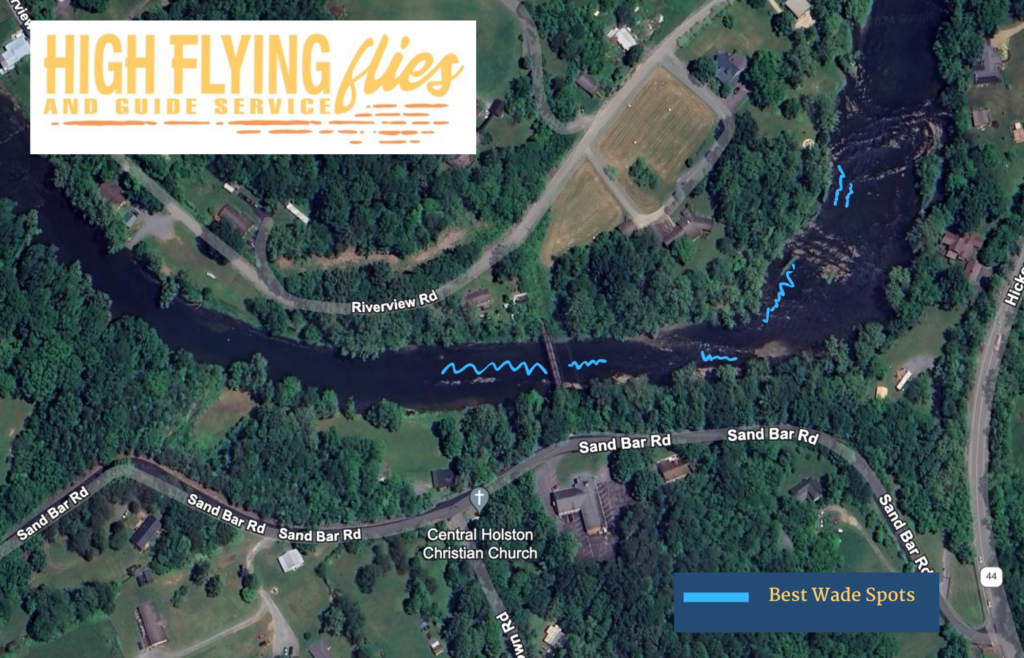

Along Big Springs Rd
Big Springs Rd runs parallel to the South Holston River, offering anglers numerous pull-off access points that serve as gateways to some of the river’s most productive fishing spots. These access points are strategically located along stretches of water that vary from fast-moving riffles to deep, slow-moving pools, providing anglers with a diversity of fishing experiences within a relatively short distance. The ease of access allows for efficient exploration of different river sections, enabling anglers to quickly adapt to where the fish are biting on any given day.
When exploring the accessible stretches along Big Springs Rd, a mobile approach is advantageous. Start by scouting the water from the bank, looking for signs of trout feeding activity such as rising fish or insect hatches. Gear up with a selection of flies that match the prevalent insects, and be prepared to change tactics, moving from nymphing in deeper waters to dry fly fishing in the riffles. Embracing a flexible strategy and taking advantage of the variety of waters accessible from Big Springs Rd can lead to a highly productive day on the South Holston
That’s A Wrap
The South Holston River, with its rich tapestry of aquatic life and stunning natural beauty, presents a world-class fly fishing experience that beckons anglers of all levels. Whether you’re drawn to the serene challenge of wade fishing or the adventurous spirit of float fishing, this river offers diverse opportunities to connect with nature and pursue the art of fly fishing. Each section, from the dynamic flows near Emmett Bridge to the tranquil waters along Big Springs Rd, holds the promise of memorable catches and experiences.
As you embark on your fishing adventures along the South Holston River, it’s crucial to remember the responsibility we all share in preserving its pristine condition. Practicing catch and release ensures the sustainability of the trout population for future generations to enjoy. Additionally, respecting the river’s natural environment—by minimizing our footprint and leaving no trace—helps maintain the ecological balance that makes this river a treasure. Let’s cherish and protect the South Holston, ensuring it remains a haven for anglers and wildlife alike.
